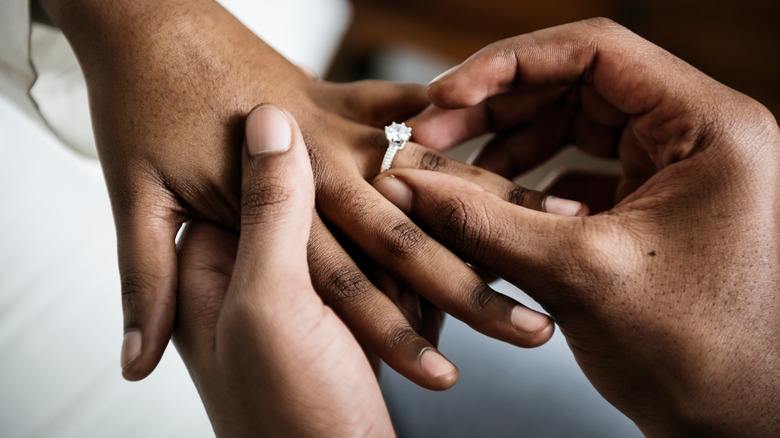Allosexual: Our Intro To The Identity Term And How It Relates To Asexuality
Many people believe that all human behavior exists on a series of spectrums. Assuming this is the case, human sexuality is certainly no exception and operates on several spectrums of its own, covering everything from sexual orientation to sexual identity and sexual monogamy. If you've been feeling overwhelmed with how many "new" terms relating to sexuality are surfacing lately, keep in mind that nearly every sexual behavior humans exhibit is as old as the species itself. Society is merely catching up with what has been there all along and providing a vocabulary for discussing a completely natural part of life.
If you've heard of asexuality and feel like you have a good grasp on what it entails, you should have no problem understanding allosexuality. The two terms simply represent opposite ends of the same spectrum. Here is your guide to understanding allosexuality, its place on the sexual desire spectrum, and how it relates to other sexual identities.
The sexual desire spectrum
The asexuality spectrum is a way to measure a person's level of sexual desire. On the low end of the spectrum is asexuality, which describes a person who experiences extremely little or no sexual desire toward other people. Anyone who falls to the right of asexual on the sexual desire spectrum is considered to be allosexual. Allosexuality is simply the absence of asexuality, meaning the presence of sexual desire toward other people. If a person is not asexual, they are by default considered allosexual.
It's important to note that there still exists an entire spectrum within the allosexual segment of the sexual desire spectrum. A person who is allosexual but experiences sexual desire quite rarely or only at a low level of intensity is considered graysexual. A person who is allosexual but only experiences sexual desire toward another when they have formed an emotional connection with them is considered demisexual. Meanwhile, someone who experiences sexual desire so often and so intensely that it interferes with their everyday life is considered hypersexual.
Allosexuality in relation to sexual orientation
Allosexuality simply refers to experiencing sexual desire toward other people. Which gender(s) a person feels sexual desire toward, on the other hand, defines their sexual orientation. A person who only experiences sexual desire toward their own gender is considered homosexual while one whose sexual desire is only directed at the opposite gender is considered heterosexual. A bisexual person experiences sexual attraction to both genders, though they may not be equally attracted to men and women. Someone who experiences sexual desire toward all genders and gender identities is generally considered pansexual and a person who is only sexually attracted to transgender and/or non-binary people is skoliosexual.
Allosexuality spans the entire spectrum of sexual orientation. An allosexual person may identify as heterosexual, homosexual, bisexual, or pansexual. An allosexual woman who falls on the demisexual portion of the sexual desire spectrum and feels sexual desire toward women she has formed emotional bonds with is a demisexual lesbian. An allosexual man who very rarely experiences sexual desire toward all gender identities is a graysexual pansexual.
Sexual orientation vs romantic orientation
An added layer of complexity when it comes to sexual orientation is the fact it can differ from a person's romantic orientation. Your romantic orientation identifies which gender(s) you feel emotional and/or intellectual attraction to, which may lead you to seek out a romantic relationship. While most people experience sexual attraction and romantic interest within the same gender(s), this is not always the case.
It is possible for an allosexual man to only feel sexual desire toward women but only experience romantic feelings toward men. He would then be considered heterosexual and homoromantic. It's also possible for a person who is asexual to experience romantic attraction and/or a desire for romantic affection. An asexual person might also be heteroromantic, homoromantic, biromantic, panromantic, or skolioromantic. On the flip side, an allosexual person may not experience romantic desire, which is known as being aromantic. A woman who is only sexually attracted to transgender men but has no romantic interest in anyone, for instance, would be considered an aromantic skoliosexual.
Sexual orientation vs genitalia preference
In addition to an allosexual person's sexual orientation and romantic orientation, they may experience a sexual attraction that is limited to a particular type of genitalia. Much like romantic orientation, most people experience a sexual orientation and a genitalia preference that naturally align. However, this is not always the case. For example, a man might be sexually attracted to people who identify as men but also experience a sexual preference for female genitalia. This may lead him to identify as a skoliosexual man who is attracted specifically to trans men with vaginas.
It is important to keep in mind when examining genitalia preferences, especially through the lens of skoliosexuality, that the transgender community is a common target for fetishism. Fetishizing trans women with penises, for example, includes seeking them out for a specific sexual experience solely based upon their genitalia and failing to view them as a whole person with emotions and preferences of their own. If this is the dynamic you're seeking, it is essential that you are upfront and honest about your intentions and that you receive explicit consent before proceeding.
How to navigate the world of sexuality spectrums
If you were born before the 2000s, you might feel like your head starts spinning every time you attempt to educate yourself about the ever-expanding language around human sexuality and related topics like gender identity. Keep in mind that the fact that you feel called to expanding your awareness at all is a sign that you're an empathetic person who desires to be on the right side of history when it comes to acceptance for all.
When you're learning new terms and their definitions, it is likely that you will slip up and misspeak at some point. This doesn't make you a bad or intolerant person. Simply apologize, correct your mistake, and move on. Your loved ones will always appreciate your willingness to listen, learn, and understand to the best of your ability. Simply keeping an open mind and accepting every learning opportunity that comes your way is enough to display to everyone who matters that your intentions are pure.





